Tour Operations Management Report: Trailfinder Case Study Analysis
VerifiedAdded on 2021/01/02
|11
|3150
|193
Report
AI Summary
This report provides a comprehensive analysis of tour operations management, using Trailfinder, a UK-based travel company, as a case study. It begins with an introduction to tour operations and the role of tour operators in the travel industry. Task 2 delves into the stages and timescales involved in developing holiday packages, including market research, planning, contracting, costing, brochure creation, advertising, operations, and post-tour management. It also examines different methods of contracting and types of tour operators, along with a detailed calculation of a holiday's selling price. Task 3 focuses on the decisions made when designing brochures, exploring both traditional and alternative methods of distribution such as e-brochures, television advertising, and social media. It also discusses various methods used by tour operators to sell tour packages, including direct sales, internet platforms, and agencies. Finally, Task 4 examines the strategic and tactical decisions taken by tour operators in different situations, providing insights into how companies like Trailfinder make decisions to succeed in the competitive travel market.
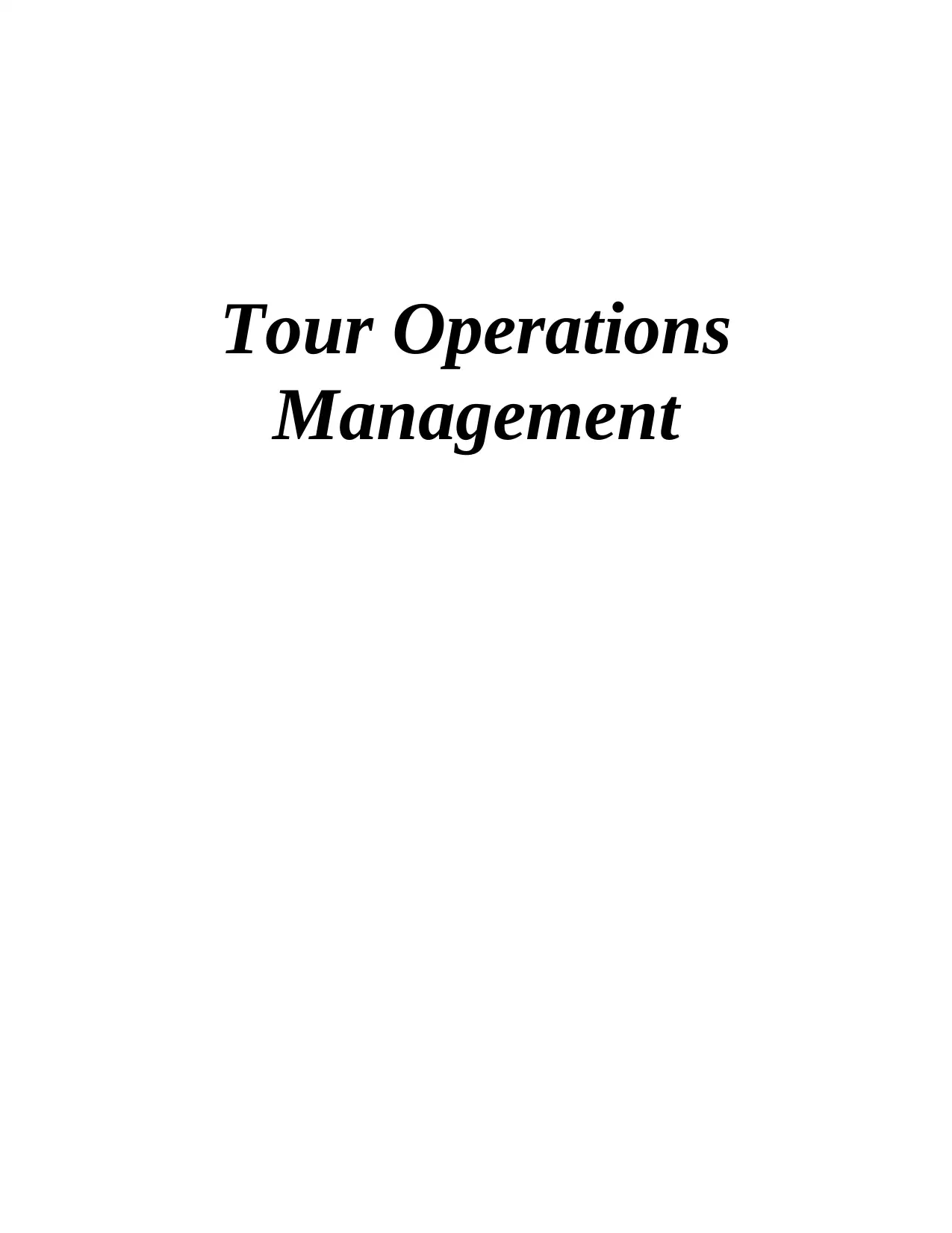
Tour Operations
Management
Management
Paraphrase This Document
Need a fresh take? Get an instant paraphrase of this document with our AI Paraphraser
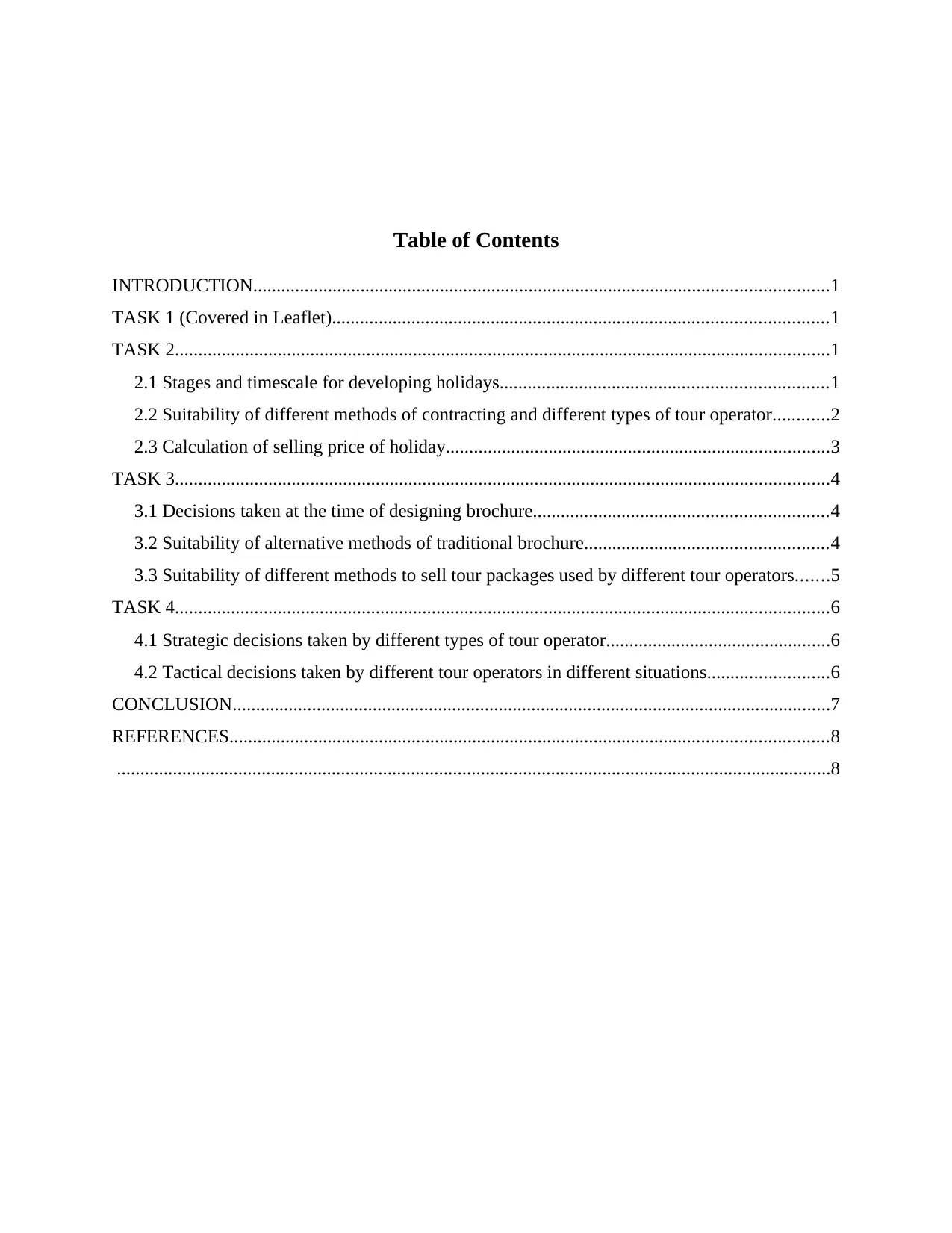
Table of Contents
INTRODUCTION...........................................................................................................................1
TASK 1 (Covered in Leaflet)..........................................................................................................1
TASK 2............................................................................................................................................1
2.1 Stages and timescale for developing holidays......................................................................1
2.2 Suitability of different methods of contracting and different types of tour operator............2
2.3 Calculation of selling price of holiday..................................................................................3
TASK 3............................................................................................................................................4
3.1 Decisions taken at the time of designing brochure...............................................................4
3.2 Suitability of alternative methods of traditional brochure....................................................4
3.3 Suitability of different methods to sell tour packages used by different tour operators.......5
TASK 4............................................................................................................................................6
4.1 Strategic decisions taken by different types of tour operator................................................6
4.2 Tactical decisions taken by different tour operators in different situations..........................6
CONCLUSION................................................................................................................................7
REFERENCES................................................................................................................................8
.........................................................................................................................................................8
INTRODUCTION...........................................................................................................................1
TASK 1 (Covered in Leaflet)..........................................................................................................1
TASK 2............................................................................................................................................1
2.1 Stages and timescale for developing holidays......................................................................1
2.2 Suitability of different methods of contracting and different types of tour operator............2
2.3 Calculation of selling price of holiday..................................................................................3
TASK 3............................................................................................................................................4
3.1 Decisions taken at the time of designing brochure...............................................................4
3.2 Suitability of alternative methods of traditional brochure....................................................4
3.3 Suitability of different methods to sell tour packages used by different tour operators.......5
TASK 4............................................................................................................................................6
4.1 Strategic decisions taken by different types of tour operator................................................6
4.2 Tactical decisions taken by different tour operators in different situations..........................6
CONCLUSION................................................................................................................................7
REFERENCES................................................................................................................................8
.........................................................................................................................................................8

⊘ This is a preview!⊘
Do you want full access?
Subscribe today to unlock all pages.

Trusted by 1+ million students worldwide
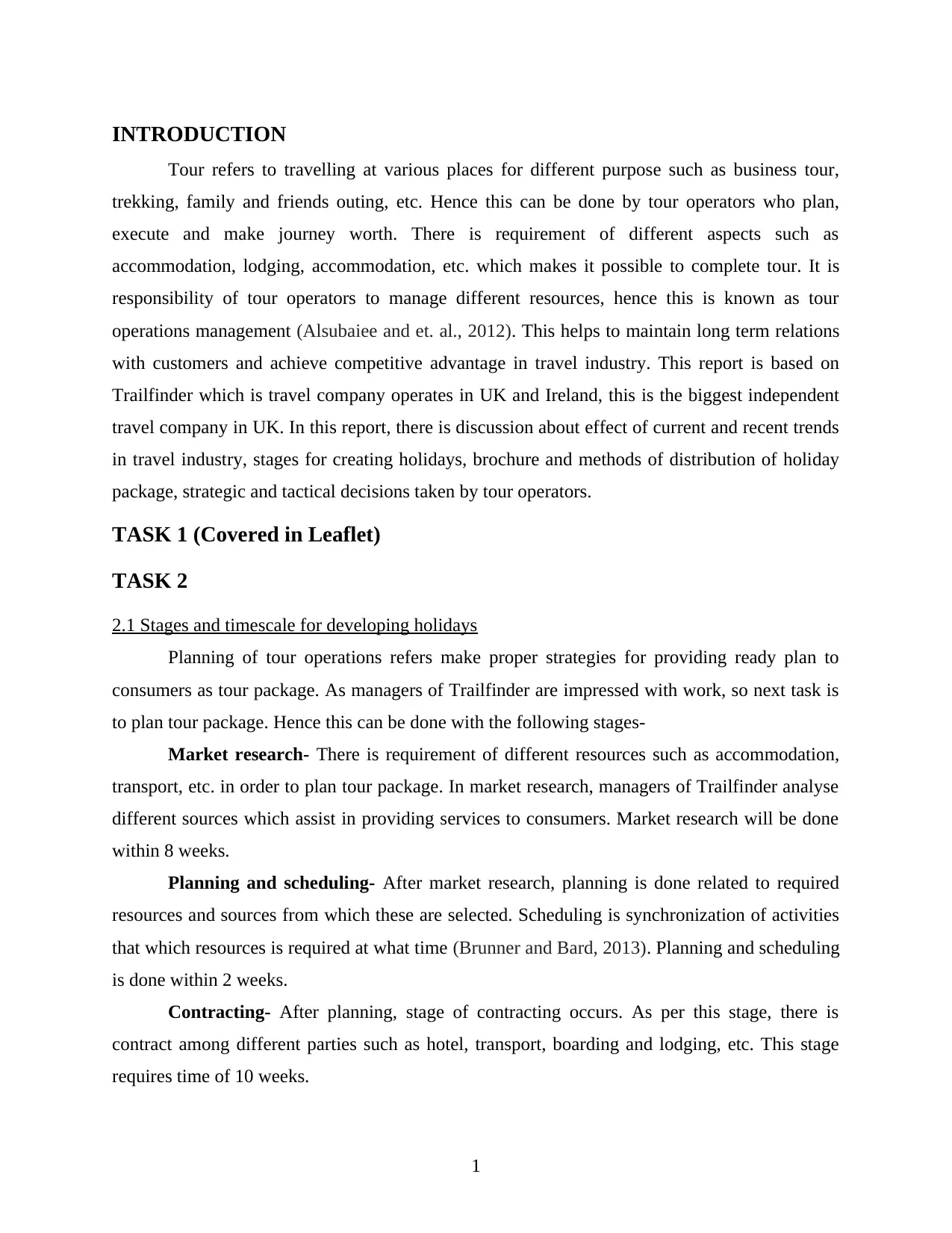
INTRODUCTION
Tour refers to travelling at various places for different purpose such as business tour,
trekking, family and friends outing, etc. Hence this can be done by tour operators who plan,
execute and make journey worth. There is requirement of different aspects such as
accommodation, lodging, accommodation, etc. which makes it possible to complete tour. It is
responsibility of tour operators to manage different resources, hence this is known as tour
operations management (Alsubaiee and et. al., 2012). This helps to maintain long term relations
with customers and achieve competitive advantage in travel industry. This report is based on
Trailfinder which is travel company operates in UK and Ireland, this is the biggest independent
travel company in UK. In this report, there is discussion about effect of current and recent trends
in travel industry, stages for creating holidays, brochure and methods of distribution of holiday
package, strategic and tactical decisions taken by tour operators.
TASK 1 (Covered in Leaflet)
TASK 2
2.1 Stages and timescale for developing holidays
Planning of tour operations refers make proper strategies for providing ready plan to
consumers as tour package. As managers of Trailfinder are impressed with work, so next task is
to plan tour package. Hence this can be done with the following stages-
Market research- There is requirement of different resources such as accommodation,
transport, etc. in order to plan tour package. In market research, managers of Trailfinder analyse
different sources which assist in providing services to consumers. Market research will be done
within 8 weeks.
Planning and scheduling- After market research, planning is done related to required
resources and sources from which these are selected. Scheduling is synchronization of activities
that which resources is required at what time (Brunner and Bard, 2013). Planning and scheduling
is done within 2 weeks.
Contracting- After planning, stage of contracting occurs. As per this stage, there is
contract among different parties such as hotel, transport, boarding and lodging, etc. This stage
requires time of 10 weeks.
1
Tour refers to travelling at various places for different purpose such as business tour,
trekking, family and friends outing, etc. Hence this can be done by tour operators who plan,
execute and make journey worth. There is requirement of different aspects such as
accommodation, lodging, accommodation, etc. which makes it possible to complete tour. It is
responsibility of tour operators to manage different resources, hence this is known as tour
operations management (Alsubaiee and et. al., 2012). This helps to maintain long term relations
with customers and achieve competitive advantage in travel industry. This report is based on
Trailfinder which is travel company operates in UK and Ireland, this is the biggest independent
travel company in UK. In this report, there is discussion about effect of current and recent trends
in travel industry, stages for creating holidays, brochure and methods of distribution of holiday
package, strategic and tactical decisions taken by tour operators.
TASK 1 (Covered in Leaflet)
TASK 2
2.1 Stages and timescale for developing holidays
Planning of tour operations refers make proper strategies for providing ready plan to
consumers as tour package. As managers of Trailfinder are impressed with work, so next task is
to plan tour package. Hence this can be done with the following stages-
Market research- There is requirement of different resources such as accommodation,
transport, etc. in order to plan tour package. In market research, managers of Trailfinder analyse
different sources which assist in providing services to consumers. Market research will be done
within 8 weeks.
Planning and scheduling- After market research, planning is done related to required
resources and sources from which these are selected. Scheduling is synchronization of activities
that which resources is required at what time (Brunner and Bard, 2013). Planning and scheduling
is done within 2 weeks.
Contracting- After planning, stage of contracting occurs. As per this stage, there is
contract among different parties such as hotel, transport, boarding and lodging, etc. This stage
requires time of 10 weeks.
1
Paraphrase This Document
Need a fresh take? Get an instant paraphrase of this document with our AI Paraphraser
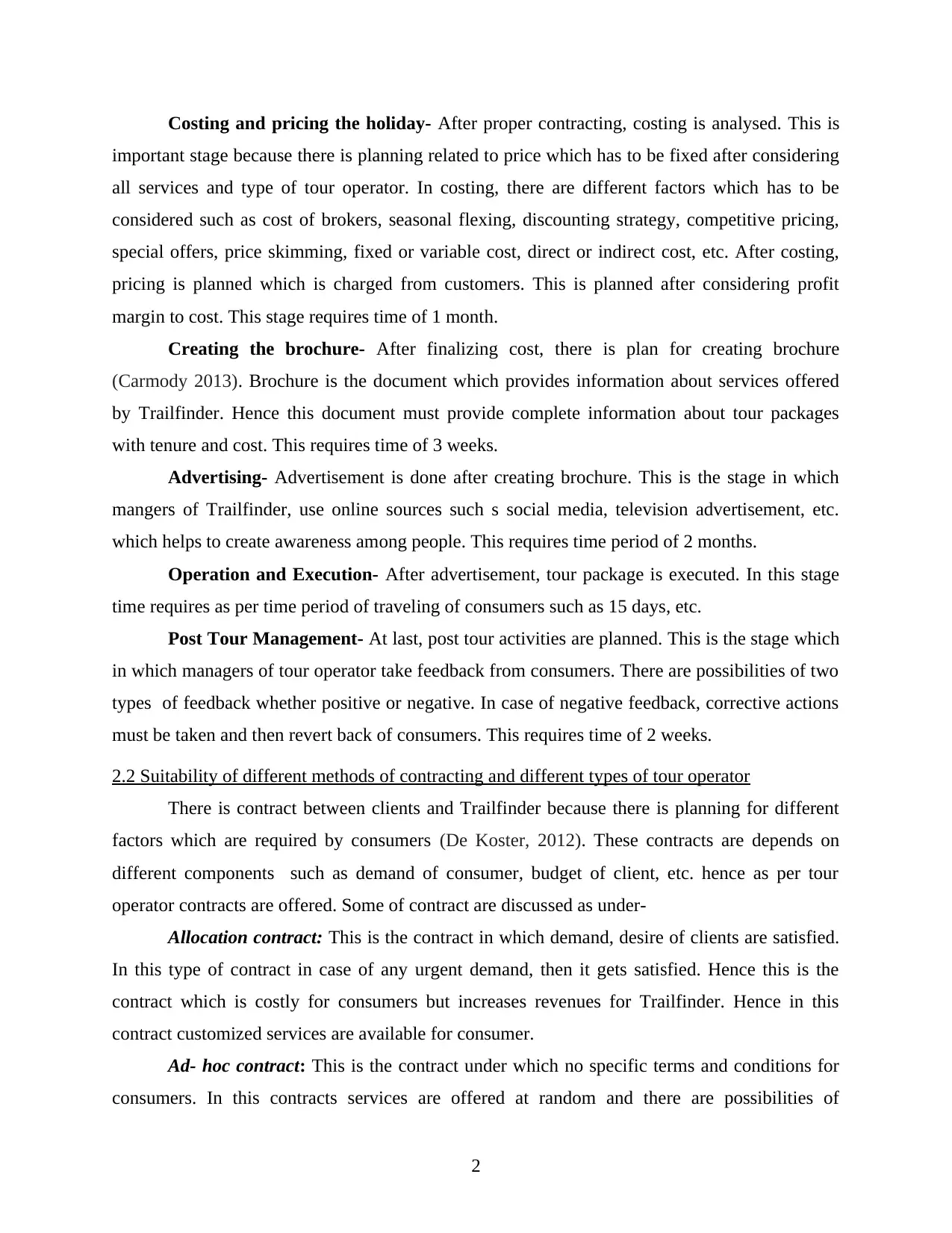
Costing and pricing the holiday- After proper contracting, costing is analysed. This is
important stage because there is planning related to price which has to be fixed after considering
all services and type of tour operator. In costing, there are different factors which has to be
considered such as cost of brokers, seasonal flexing, discounting strategy, competitive pricing,
special offers, price skimming, fixed or variable cost, direct or indirect cost, etc. After costing,
pricing is planned which is charged from customers. This is planned after considering profit
margin to cost. This stage requires time of 1 month.
Creating the brochure- After finalizing cost, there is plan for creating brochure
(Carmody 2013). Brochure is the document which provides information about services offered
by Trailfinder. Hence this document must provide complete information about tour packages
with tenure and cost. This requires time of 3 weeks.
Advertising- Advertisement is done after creating brochure. This is the stage in which
mangers of Trailfinder, use online sources such s social media, television advertisement, etc.
which helps to create awareness among people. This requires time period of 2 months.
Operation and Execution- After advertisement, tour package is executed. In this stage
time requires as per time period of traveling of consumers such as 15 days, etc.
Post Tour Management- At last, post tour activities are planned. This is the stage which
in which managers of tour operator take feedback from consumers. There are possibilities of two
types of feedback whether positive or negative. In case of negative feedback, corrective actions
must be taken and then revert back of consumers. This requires time of 2 weeks.
2.2 Suitability of different methods of contracting and different types of tour operator
There is contract between clients and Trailfinder because there is planning for different
factors which are required by consumers (De Koster, 2012). These contracts are depends on
different components such as demand of consumer, budget of client, etc. hence as per tour
operator contracts are offered. Some of contract are discussed as under-
Allocation contract: This is the contract in which demand, desire of clients are satisfied.
In this type of contract in case of any urgent demand, then it gets satisfied. Hence this is the
contract which is costly for consumers but increases revenues for Trailfinder. Hence in this
contract customized services are available for consumer.
Ad- hoc contract: This is the contract under which no specific terms and conditions for
consumers. In this contracts services are offered at random and there are possibilities of
2
important stage because there is planning related to price which has to be fixed after considering
all services and type of tour operator. In costing, there are different factors which has to be
considered such as cost of brokers, seasonal flexing, discounting strategy, competitive pricing,
special offers, price skimming, fixed or variable cost, direct or indirect cost, etc. After costing,
pricing is planned which is charged from customers. This is planned after considering profit
margin to cost. This stage requires time of 1 month.
Creating the brochure- After finalizing cost, there is plan for creating brochure
(Carmody 2013). Brochure is the document which provides information about services offered
by Trailfinder. Hence this document must provide complete information about tour packages
with tenure and cost. This requires time of 3 weeks.
Advertising- Advertisement is done after creating brochure. This is the stage in which
mangers of Trailfinder, use online sources such s social media, television advertisement, etc.
which helps to create awareness among people. This requires time period of 2 months.
Operation and Execution- After advertisement, tour package is executed. In this stage
time requires as per time period of traveling of consumers such as 15 days, etc.
Post Tour Management- At last, post tour activities are planned. This is the stage which
in which managers of tour operator take feedback from consumers. There are possibilities of two
types of feedback whether positive or negative. In case of negative feedback, corrective actions
must be taken and then revert back of consumers. This requires time of 2 weeks.
2.2 Suitability of different methods of contracting and different types of tour operator
There is contract between clients and Trailfinder because there is planning for different
factors which are required by consumers (De Koster, 2012). These contracts are depends on
different components such as demand of consumer, budget of client, etc. hence as per tour
operator contracts are offered. Some of contract are discussed as under-
Allocation contract: This is the contract in which demand, desire of clients are satisfied.
In this type of contract in case of any urgent demand, then it gets satisfied. Hence this is the
contract which is costly for consumers but increases revenues for Trailfinder. Hence in this
contract customized services are available for consumer.
Ad- hoc contract: This is the contract under which no specific terms and conditions for
consumers. In this contracts services are offered at random and there are possibilities of
2
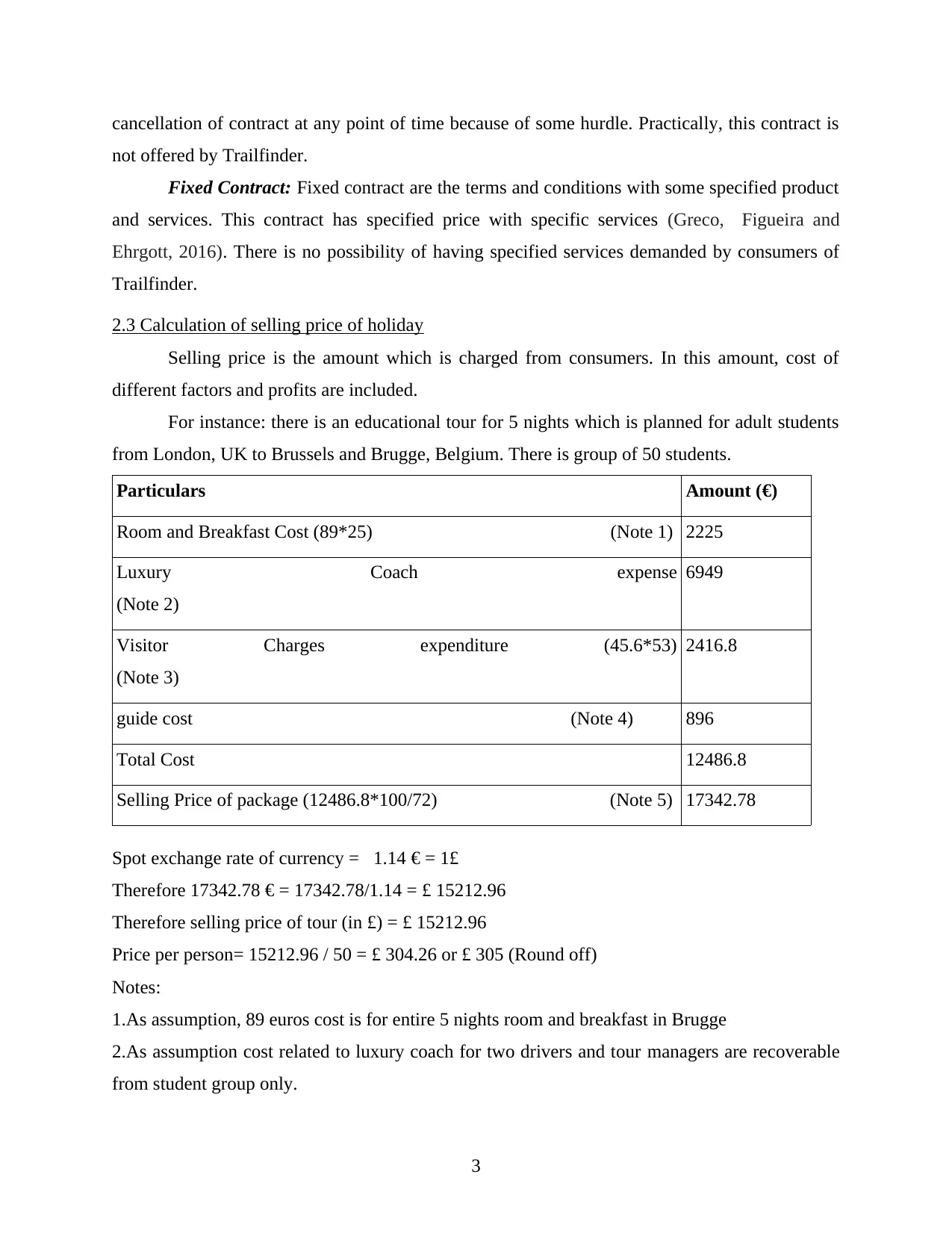
cancellation of contract at any point of time because of some hurdle. Practically, this contract is
not offered by Trailfinder.
Fixed Contract: Fixed contract are the terms and conditions with some specified product
and services. This contract has specified price with specific services (Greco, Figueira and
Ehrgott, 2016). There is no possibility of having specified services demanded by consumers of
Trailfinder.
2.3 Calculation of selling price of holiday
Selling price is the amount which is charged from consumers. In this amount, cost of
different factors and profits are included.
For instance: there is an educational tour for 5 nights which is planned for adult students
from London, UK to Brussels and Brugge, Belgium. There is group of 50 students.
Particulars Amount (€)
Room and Breakfast Cost (89*25) (Note 1) 2225
Luxury Coach expense
(Note 2)
6949
Visitor Charges expenditure (45.6*53)
(Note 3)
2416.8
guide cost (Note 4) 896
Total Cost 12486.8
Selling Price of package (12486.8*100/72) (Note 5) 17342.78
Spot exchange rate of currency = 1.14 € = 1£
Therefore 17342.78 € = 17342.78/1.14 = £ 15212.96
Therefore selling price of tour (in £) = £ 15212.96
Price per person= 15212.96 / 50 = £ 304.26 or £ 305 (Round off)
Notes:
1.As assumption, 89 euros cost is for entire 5 nights room and breakfast in Brugge
2.As assumption cost related to luxury coach for two drivers and tour managers are recoverable
from student group only.
3
not offered by Trailfinder.
Fixed Contract: Fixed contract are the terms and conditions with some specified product
and services. This contract has specified price with specific services (Greco, Figueira and
Ehrgott, 2016). There is no possibility of having specified services demanded by consumers of
Trailfinder.
2.3 Calculation of selling price of holiday
Selling price is the amount which is charged from consumers. In this amount, cost of
different factors and profits are included.
For instance: there is an educational tour for 5 nights which is planned for adult students
from London, UK to Brussels and Brugge, Belgium. There is group of 50 students.
Particulars Amount (€)
Room and Breakfast Cost (89*25) (Note 1) 2225
Luxury Coach expense
(Note 2)
6949
Visitor Charges expenditure (45.6*53)
(Note 3)
2416.8
guide cost (Note 4) 896
Total Cost 12486.8
Selling Price of package (12486.8*100/72) (Note 5) 17342.78
Spot exchange rate of currency = 1.14 € = 1£
Therefore 17342.78 € = 17342.78/1.14 = £ 15212.96
Therefore selling price of tour (in £) = £ 15212.96
Price per person= 15212.96 / 50 = £ 304.26 or £ 305 (Round off)
Notes:
1.As assumption, 89 euros cost is for entire 5 nights room and breakfast in Brugge
2.As assumption cost related to luxury coach for two drivers and tour managers are recoverable
from student group only.
3
⊘ This is a preview!⊘
Do you want full access?
Subscribe today to unlock all pages.

Trusted by 1+ million students worldwide
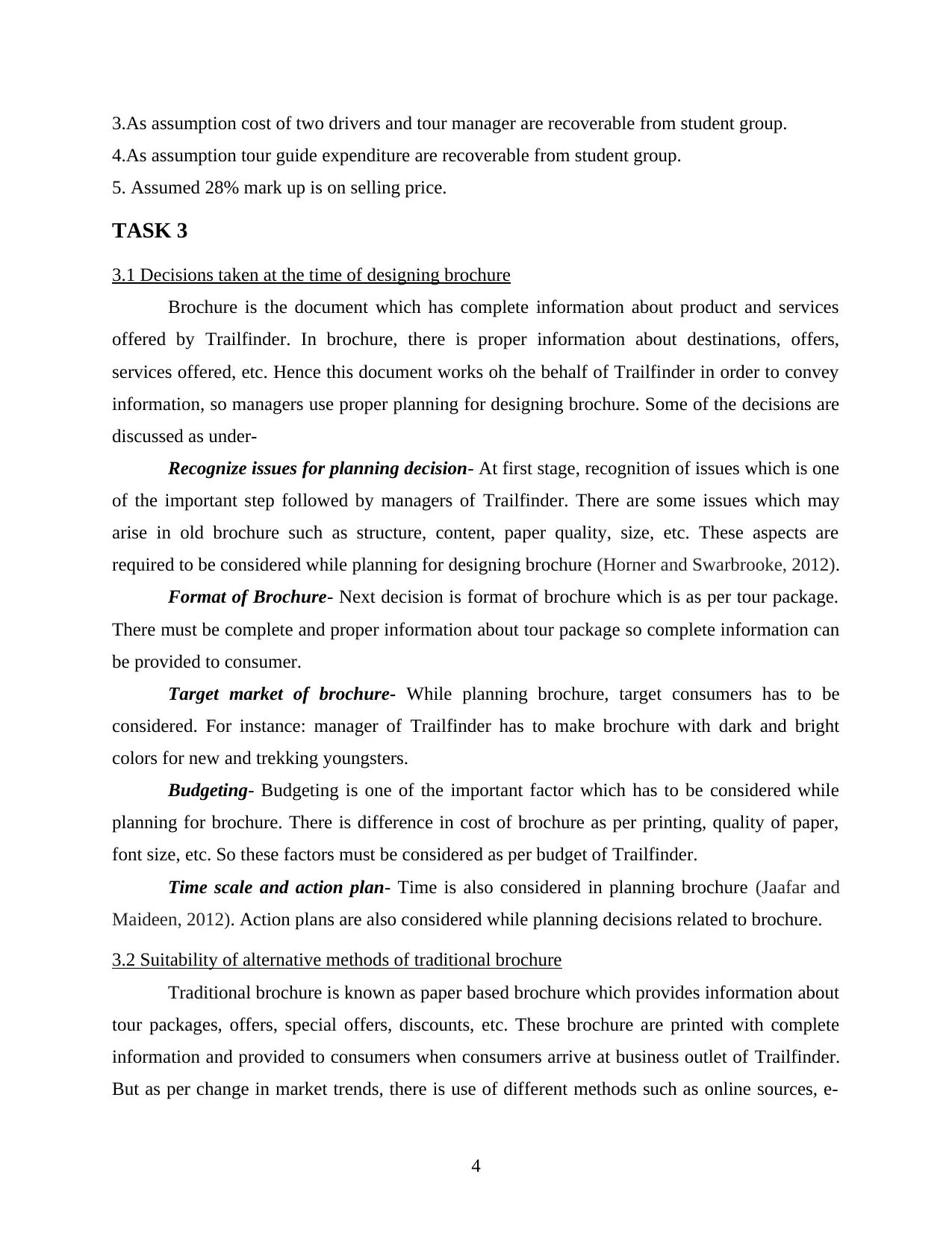
3.As assumption cost of two drivers and tour manager are recoverable from student group.
4.As assumption tour guide expenditure are recoverable from student group.
5. Assumed 28% mark up is on selling price.
TASK 3
3.1 Decisions taken at the time of designing brochure
Brochure is the document which has complete information about product and services
offered by Trailfinder. In brochure, there is proper information about destinations, offers,
services offered, etc. Hence this document works oh the behalf of Trailfinder in order to convey
information, so managers use proper planning for designing brochure. Some of the decisions are
discussed as under-
Recognize issues for planning decision- At first stage, recognition of issues which is one
of the important step followed by managers of Trailfinder. There are some issues which may
arise in old brochure such as structure, content, paper quality, size, etc. These aspects are
required to be considered while planning for designing brochure (Horner and Swarbrooke, 2012).
Format of Brochure- Next decision is format of brochure which is as per tour package.
There must be complete and proper information about tour package so complete information can
be provided to consumer.
Target market of brochure- While planning brochure, target consumers has to be
considered. For instance: manager of Trailfinder has to make brochure with dark and bright
colors for new and trekking youngsters.
Budgeting- Budgeting is one of the important factor which has to be considered while
planning for brochure. There is difference in cost of brochure as per printing, quality of paper,
font size, etc. So these factors must be considered as per budget of Trailfinder.
Time scale and action plan- Time is also considered in planning brochure (Jaafar and
Maideen, 2012). Action plans are also considered while planning decisions related to brochure.
3.2 Suitability of alternative methods of traditional brochure
Traditional brochure is known as paper based brochure which provides information about
tour packages, offers, special offers, discounts, etc. These brochure are printed with complete
information and provided to consumers when consumers arrive at business outlet of Trailfinder.
But as per change in market trends, there is use of different methods such as online sources, e-
4
4.As assumption tour guide expenditure are recoverable from student group.
5. Assumed 28% mark up is on selling price.
TASK 3
3.1 Decisions taken at the time of designing brochure
Brochure is the document which has complete information about product and services
offered by Trailfinder. In brochure, there is proper information about destinations, offers,
services offered, etc. Hence this document works oh the behalf of Trailfinder in order to convey
information, so managers use proper planning for designing brochure. Some of the decisions are
discussed as under-
Recognize issues for planning decision- At first stage, recognition of issues which is one
of the important step followed by managers of Trailfinder. There are some issues which may
arise in old brochure such as structure, content, paper quality, size, etc. These aspects are
required to be considered while planning for designing brochure (Horner and Swarbrooke, 2012).
Format of Brochure- Next decision is format of brochure which is as per tour package.
There must be complete and proper information about tour package so complete information can
be provided to consumer.
Target market of brochure- While planning brochure, target consumers has to be
considered. For instance: manager of Trailfinder has to make brochure with dark and bright
colors for new and trekking youngsters.
Budgeting- Budgeting is one of the important factor which has to be considered while
planning for brochure. There is difference in cost of brochure as per printing, quality of paper,
font size, etc. So these factors must be considered as per budget of Trailfinder.
Time scale and action plan- Time is also considered in planning brochure (Jaafar and
Maideen, 2012). Action plans are also considered while planning decisions related to brochure.
3.2 Suitability of alternative methods of traditional brochure
Traditional brochure is known as paper based brochure which provides information about
tour packages, offers, special offers, discounts, etc. These brochure are printed with complete
information and provided to consumers when consumers arrive at business outlet of Trailfinder.
But as per change in market trends, there is use of different methods such as online sources, e-
4
Paraphrase This Document
Need a fresh take? Get an instant paraphrase of this document with our AI Paraphraser
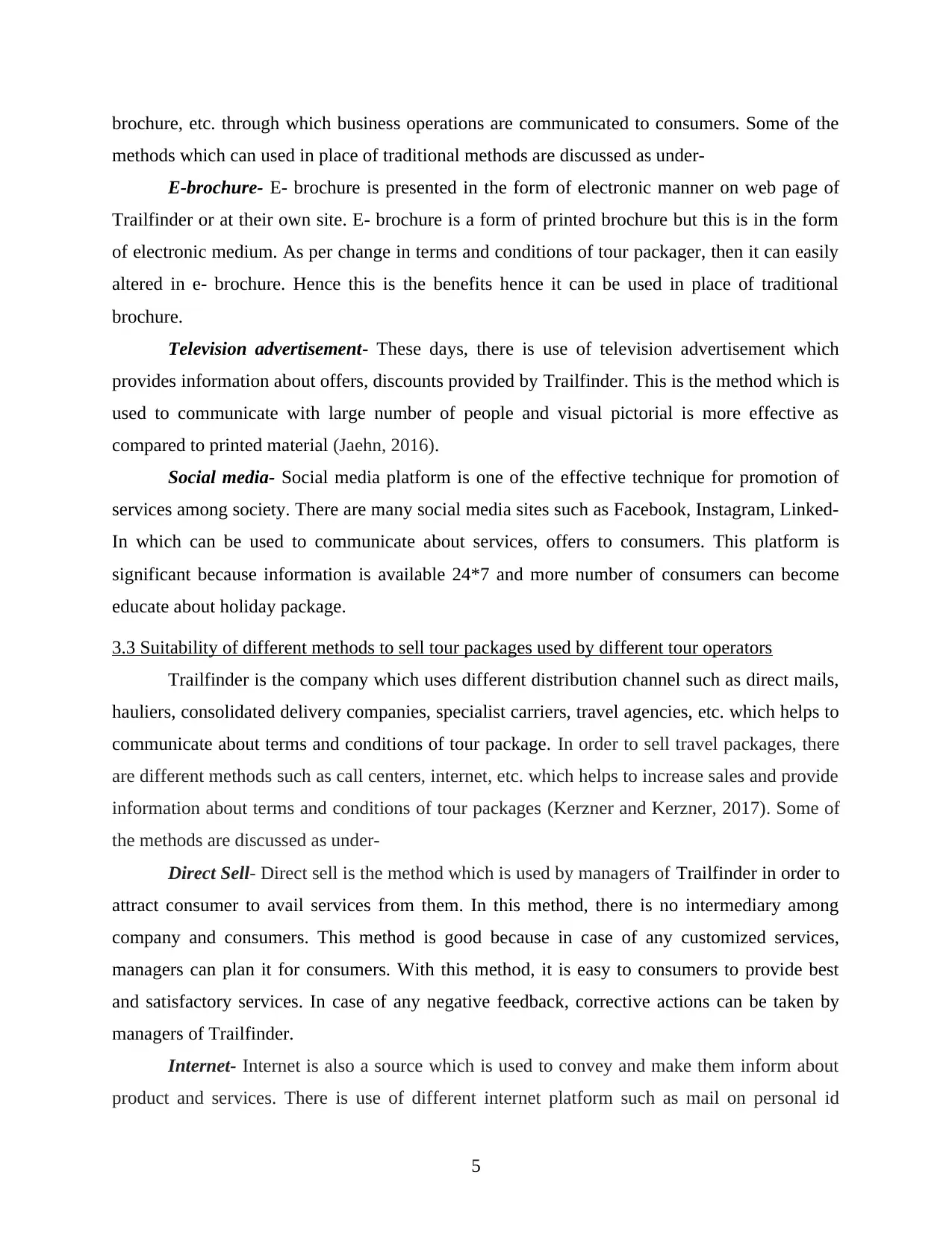
brochure, etc. through which business operations are communicated to consumers. Some of the
methods which can used in place of traditional methods are discussed as under-
E-brochure- E- brochure is presented in the form of electronic manner on web page of
Trailfinder or at their own site. E- brochure is a form of printed brochure but this is in the form
of electronic medium. As per change in terms and conditions of tour packager, then it can easily
altered in e- brochure. Hence this is the benefits hence it can be used in place of traditional
brochure.
Television advertisement- These days, there is use of television advertisement which
provides information about offers, discounts provided by Trailfinder. This is the method which is
used to communicate with large number of people and visual pictorial is more effective as
compared to printed material (Jaehn, 2016).
Social media- Social media platform is one of the effective technique for promotion of
services among society. There are many social media sites such as Facebook, Instagram, Linked-
In which can be used to communicate about services, offers to consumers. This platform is
significant because information is available 24*7 and more number of consumers can become
educate about holiday package.
3.3 Suitability of different methods to sell tour packages used by different tour operators
Trailfinder is the company which uses different distribution channel such as direct mails,
hauliers, consolidated delivery companies, specialist carriers, travel agencies, etc. which helps to
communicate about terms and conditions of tour package. In order to sell travel packages, there
are different methods such as call centers, internet, etc. which helps to increase sales and provide
information about terms and conditions of tour packages (Kerzner and Kerzner, 2017). Some of
the methods are discussed as under-
Direct Sell- Direct sell is the method which is used by managers of Trailfinder in order to
attract consumer to avail services from them. In this method, there is no intermediary among
company and consumers. This method is good because in case of any customized services,
managers can plan it for consumers. With this method, it is easy to consumers to provide best
and satisfactory services. In case of any negative feedback, corrective actions can be taken by
managers of Trailfinder.
Internet- Internet is also a source which is used to convey and make them inform about
product and services. There is use of different internet platform such as mail on personal id
5
methods which can used in place of traditional methods are discussed as under-
E-brochure- E- brochure is presented in the form of electronic manner on web page of
Trailfinder or at their own site. E- brochure is a form of printed brochure but this is in the form
of electronic medium. As per change in terms and conditions of tour packager, then it can easily
altered in e- brochure. Hence this is the benefits hence it can be used in place of traditional
brochure.
Television advertisement- These days, there is use of television advertisement which
provides information about offers, discounts provided by Trailfinder. This is the method which is
used to communicate with large number of people and visual pictorial is more effective as
compared to printed material (Jaehn, 2016).
Social media- Social media platform is one of the effective technique for promotion of
services among society. There are many social media sites such as Facebook, Instagram, Linked-
In which can be used to communicate about services, offers to consumers. This platform is
significant because information is available 24*7 and more number of consumers can become
educate about holiday package.
3.3 Suitability of different methods to sell tour packages used by different tour operators
Trailfinder is the company which uses different distribution channel such as direct mails,
hauliers, consolidated delivery companies, specialist carriers, travel agencies, etc. which helps to
communicate about terms and conditions of tour package. In order to sell travel packages, there
are different methods such as call centers, internet, etc. which helps to increase sales and provide
information about terms and conditions of tour packages (Kerzner and Kerzner, 2017). Some of
the methods are discussed as under-
Direct Sell- Direct sell is the method which is used by managers of Trailfinder in order to
attract consumer to avail services from them. In this method, there is no intermediary among
company and consumers. This method is good because in case of any customized services,
managers can plan it for consumers. With this method, it is easy to consumers to provide best
and satisfactory services. In case of any negative feedback, corrective actions can be taken by
managers of Trailfinder.
Internet- Internet is also a source which is used to convey and make them inform about
product and services. There is use of different internet platform such as mail on personal id
5
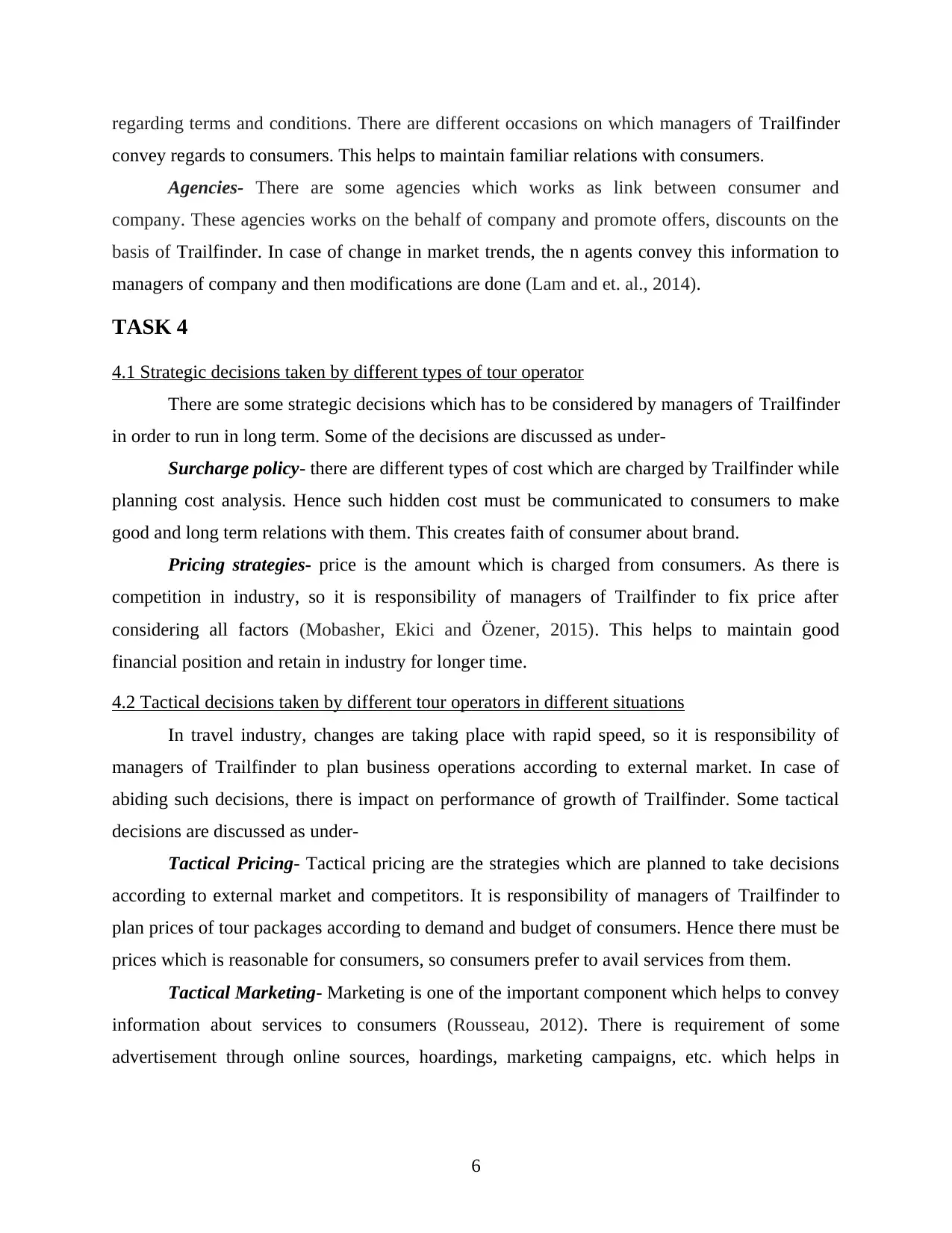
regarding terms and conditions. There are different occasions on which managers of Trailfinder
convey regards to consumers. This helps to maintain familiar relations with consumers.
Agencies- There are some agencies which works as link between consumer and
company. These agencies works on the behalf of company and promote offers, discounts on the
basis of Trailfinder. In case of change in market trends, the n agents convey this information to
managers of company and then modifications are done (Lam and et. al., 2014).
TASK 4
4.1 Strategic decisions taken by different types of tour operator
There are some strategic decisions which has to be considered by managers of Trailfinder
in order to run in long term. Some of the decisions are discussed as under-
Surcharge policy- there are different types of cost which are charged by Trailfinder while
planning cost analysis. Hence such hidden cost must be communicated to consumers to make
good and long term relations with them. This creates faith of consumer about brand.
Pricing strategies- price is the amount which is charged from consumers. As there is
competition in industry, so it is responsibility of managers of Trailfinder to fix price after
considering all factors (Mobasher, Ekici and Özener, 2015). This helps to maintain good
financial position and retain in industry for longer time.
4.2 Tactical decisions taken by different tour operators in different situations
In travel industry, changes are taking place with rapid speed, so it is responsibility of
managers of Trailfinder to plan business operations according to external market. In case of
abiding such decisions, there is impact on performance of growth of Trailfinder. Some tactical
decisions are discussed as under-
Tactical Pricing- Tactical pricing are the strategies which are planned to take decisions
according to external market and competitors. It is responsibility of managers of Trailfinder to
plan prices of tour packages according to demand and budget of consumers. Hence there must be
prices which is reasonable for consumers, so consumers prefer to avail services from them.
Tactical Marketing- Marketing is one of the important component which helps to convey
information about services to consumers (Rousseau, 2012). There is requirement of some
advertisement through online sources, hoardings, marketing campaigns, etc. which helps in
6
convey regards to consumers. This helps to maintain familiar relations with consumers.
Agencies- There are some agencies which works as link between consumer and
company. These agencies works on the behalf of company and promote offers, discounts on the
basis of Trailfinder. In case of change in market trends, the n agents convey this information to
managers of company and then modifications are done (Lam and et. al., 2014).
TASK 4
4.1 Strategic decisions taken by different types of tour operator
There are some strategic decisions which has to be considered by managers of Trailfinder
in order to run in long term. Some of the decisions are discussed as under-
Surcharge policy- there are different types of cost which are charged by Trailfinder while
planning cost analysis. Hence such hidden cost must be communicated to consumers to make
good and long term relations with them. This creates faith of consumer about brand.
Pricing strategies- price is the amount which is charged from consumers. As there is
competition in industry, so it is responsibility of managers of Trailfinder to fix price after
considering all factors (Mobasher, Ekici and Özener, 2015). This helps to maintain good
financial position and retain in industry for longer time.
4.2 Tactical decisions taken by different tour operators in different situations
In travel industry, changes are taking place with rapid speed, so it is responsibility of
managers of Trailfinder to plan business operations according to external market. In case of
abiding such decisions, there is impact on performance of growth of Trailfinder. Some tactical
decisions are discussed as under-
Tactical Pricing- Tactical pricing are the strategies which are planned to take decisions
according to external market and competitors. It is responsibility of managers of Trailfinder to
plan prices of tour packages according to demand and budget of consumers. Hence there must be
prices which is reasonable for consumers, so consumers prefer to avail services from them.
Tactical Marketing- Marketing is one of the important component which helps to convey
information about services to consumers (Rousseau, 2012). There is requirement of some
advertisement through online sources, hoardings, marketing campaigns, etc. which helps in
6
⊘ This is a preview!⊘
Do you want full access?
Subscribe today to unlock all pages.

Trusted by 1+ million students worldwide
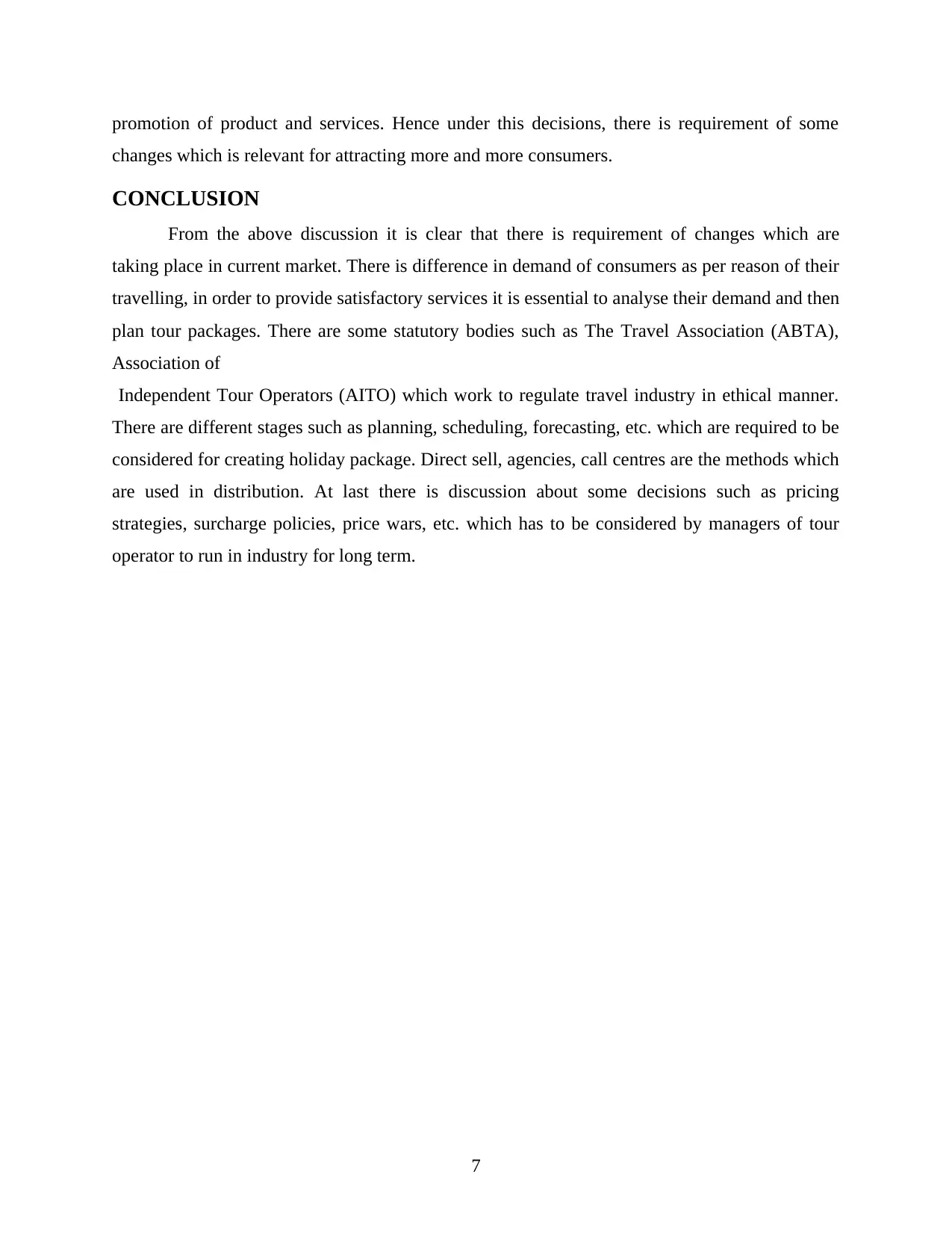
promotion of product and services. Hence under this decisions, there is requirement of some
changes which is relevant for attracting more and more consumers.
CONCLUSION
From the above discussion it is clear that there is requirement of changes which are
taking place in current market. There is difference in demand of consumers as per reason of their
travelling, in order to provide satisfactory services it is essential to analyse their demand and then
plan tour packages. There are some statutory bodies such as The Travel Association (ABTA),
Association of
Independent Tour Operators (AITO) which work to regulate travel industry in ethical manner.
There are different stages such as planning, scheduling, forecasting, etc. which are required to be
considered for creating holiday package. Direct sell, agencies, call centres are the methods which
are used in distribution. At last there is discussion about some decisions such as pricing
strategies, surcharge policies, price wars, etc. which has to be considered by managers of tour
operator to run in industry for long term.
7
changes which is relevant for attracting more and more consumers.
CONCLUSION
From the above discussion it is clear that there is requirement of changes which are
taking place in current market. There is difference in demand of consumers as per reason of their
travelling, in order to provide satisfactory services it is essential to analyse their demand and then
plan tour packages. There are some statutory bodies such as The Travel Association (ABTA),
Association of
Independent Tour Operators (AITO) which work to regulate travel industry in ethical manner.
There are different stages such as planning, scheduling, forecasting, etc. which are required to be
considered for creating holiday package. Direct sell, agencies, call centres are the methods which
are used in distribution. At last there is discussion about some decisions such as pricing
strategies, surcharge policies, price wars, etc. which has to be considered by managers of tour
operator to run in industry for long term.
7
Paraphrase This Document
Need a fresh take? Get an instant paraphrase of this document with our AI Paraphraser
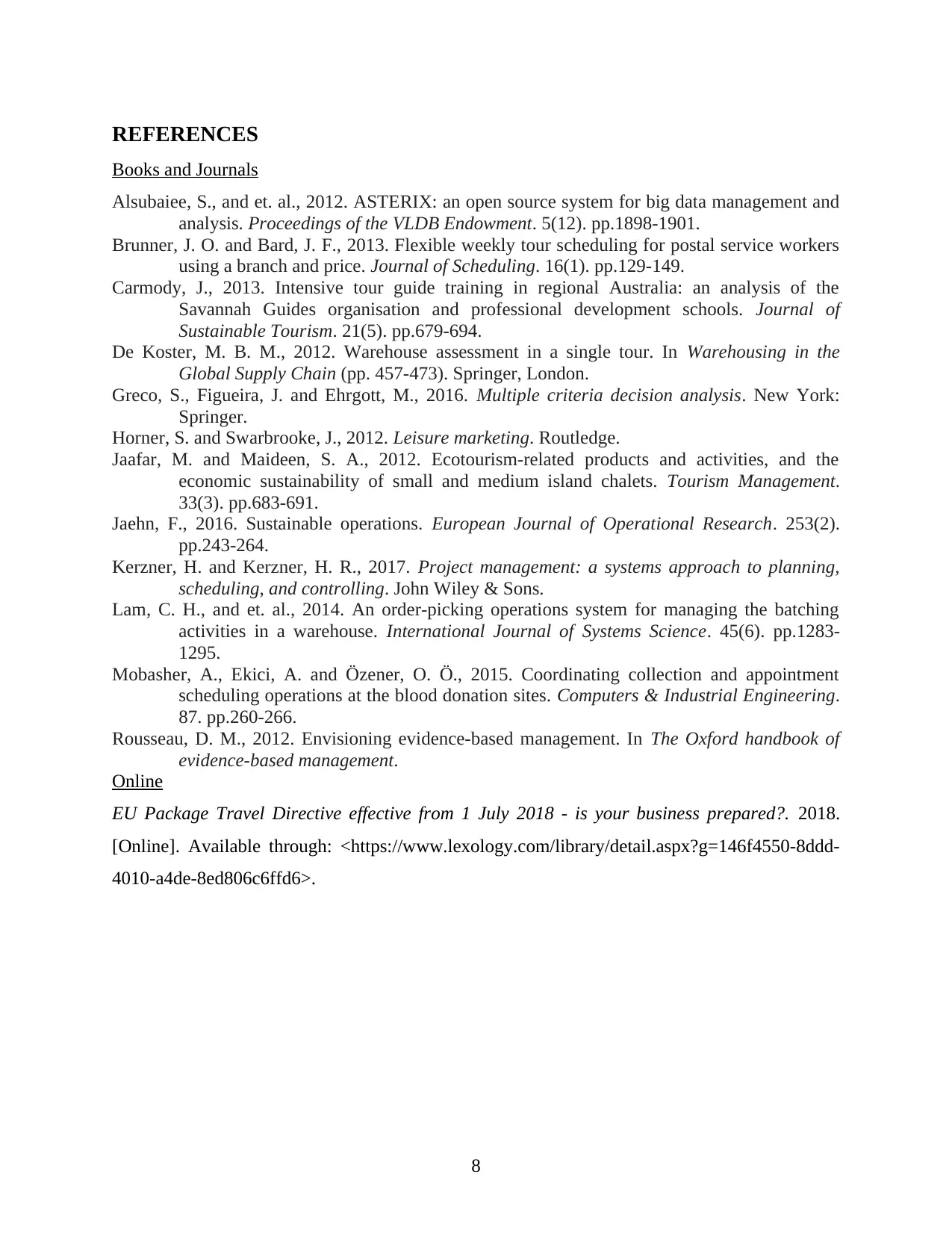
REFERENCES
Books and Journals
Alsubaiee, S., and et. al., 2012. ASTERIX: an open source system for big data management and
analysis. Proceedings of the VLDB Endowment. 5(12). pp.1898-1901.
Brunner, J. O. and Bard, J. F., 2013. Flexible weekly tour scheduling for postal service workers
using a branch and price. Journal of Scheduling. 16(1). pp.129-149.
Carmody, J., 2013. Intensive tour guide training in regional Australia: an analysis of the
Savannah Guides organisation and professional development schools. Journal of
Sustainable Tourism. 21(5). pp.679-694.
De Koster, M. B. M., 2012. Warehouse assessment in a single tour. In Warehousing in the
Global Supply Chain (pp. 457-473). Springer, London.
Greco, S., Figueira, J. and Ehrgott, M., 2016. Multiple criteria decision analysis. New York:
Springer.
Horner, S. and Swarbrooke, J., 2012. Leisure marketing. Routledge.
Jaafar, M. and Maideen, S. A., 2012. Ecotourism-related products and activities, and the
economic sustainability of small and medium island chalets. Tourism Management.
33(3). pp.683-691.
Jaehn, F., 2016. Sustainable operations. European Journal of Operational Research. 253(2).
pp.243-264.
Kerzner, H. and Kerzner, H. R., 2017. Project management: a systems approach to planning,
scheduling, and controlling. John Wiley & Sons.
Lam, C. H., and et. al., 2014. An order-picking operations system for managing the batching
activities in a warehouse. International Journal of Systems Science. 45(6). pp.1283-
1295.
Mobasher, A., Ekici, A. and Özener, O. Ö., 2015. Coordinating collection and appointment
scheduling operations at the blood donation sites. Computers & Industrial Engineering.
87. pp.260-266.
Rousseau, D. M., 2012. Envisioning evidence-based management. In The Oxford handbook of
evidence-based management.
Online
EU Package Travel Directive effective from 1 July 2018 - is your business prepared?. 2018.
[Online]. Available through: <https://www.lexology.com/library/detail.aspx?g=146f4550-8ddd-
4010-a4de-8ed806c6ffd6>.
8
Books and Journals
Alsubaiee, S., and et. al., 2012. ASTERIX: an open source system for big data management and
analysis. Proceedings of the VLDB Endowment. 5(12). pp.1898-1901.
Brunner, J. O. and Bard, J. F., 2013. Flexible weekly tour scheduling for postal service workers
using a branch and price. Journal of Scheduling. 16(1). pp.129-149.
Carmody, J., 2013. Intensive tour guide training in regional Australia: an analysis of the
Savannah Guides organisation and professional development schools. Journal of
Sustainable Tourism. 21(5). pp.679-694.
De Koster, M. B. M., 2012. Warehouse assessment in a single tour. In Warehousing in the
Global Supply Chain (pp. 457-473). Springer, London.
Greco, S., Figueira, J. and Ehrgott, M., 2016. Multiple criteria decision analysis. New York:
Springer.
Horner, S. and Swarbrooke, J., 2012. Leisure marketing. Routledge.
Jaafar, M. and Maideen, S. A., 2012. Ecotourism-related products and activities, and the
economic sustainability of small and medium island chalets. Tourism Management.
33(3). pp.683-691.
Jaehn, F., 2016. Sustainable operations. European Journal of Operational Research. 253(2).
pp.243-264.
Kerzner, H. and Kerzner, H. R., 2017. Project management: a systems approach to planning,
scheduling, and controlling. John Wiley & Sons.
Lam, C. H., and et. al., 2014. An order-picking operations system for managing the batching
activities in a warehouse. International Journal of Systems Science. 45(6). pp.1283-
1295.
Mobasher, A., Ekici, A. and Özener, O. Ö., 2015. Coordinating collection and appointment
scheduling operations at the blood donation sites. Computers & Industrial Engineering.
87. pp.260-266.
Rousseau, D. M., 2012. Envisioning evidence-based management. In The Oxford handbook of
evidence-based management.
Online
EU Package Travel Directive effective from 1 July 2018 - is your business prepared?. 2018.
[Online]. Available through: <https://www.lexology.com/library/detail.aspx?g=146f4550-8ddd-
4010-a4de-8ed806c6ffd6>.
8
1 out of 11
Related Documents
Your All-in-One AI-Powered Toolkit for Academic Success.
+13062052269
info@desklib.com
Available 24*7 on WhatsApp / Email
![[object Object]](/_next/static/media/star-bottom.7253800d.svg)
Unlock your academic potential
Copyright © 2020–2025 A2Z Services. All Rights Reserved. Developed and managed by ZUCOL.





